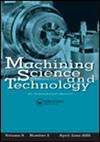Correlation between surface integrity characteristics in high-speed grinding of Ti-6Al-4V
IF 2.6
4区 工程技术
Q2 ENGINEERING, MANUFACTURING
引用次数: 0
Abstract
Abstract The present article establishes a fundamental correlation between surface integrity characteristics of the finished surface with the normal to tangential force ratio (Fn/Ft) in the grinding of Ti-6Al-4V. The subsurface deformation, crystallographic texture, surface redeposition, and residual stress were studied in the surface integrity characteristics. The XRD result indicated deformation-induced texturing of the α-002 basal plane of Ti-6Al-4V. The gradual reduction in texturing along the depth was confirmed by the Gi-XRD investigation. The relative intensity of the 002 peak was utilized as a quantitative indicator of subsurface deformation. The XRD and the metallographic study revealed a considerable amount of subsurface deformation at a higher grinding speed (vs ) and an enhanced material removal rate (MRR). Intense surface redeposition was also observed for higher vs and increased MRR grinding conditions. The surface redeposition was identified as an influencing factor that escalates the subsurface deformation and crystallographic texture. In addition, the residual stress was found to be more compressive at enhanced vs and MRR. Further, a higher force ratio Fn/Ft was noticed for the grinding conditions that revealed significant subsurface deformation, strong crystallographic texture, surface redeposition, and more compressive residual stress. Eventually, a correlation was found between the force ratio Fn/Ft and all these surface integrity characteristics.Ti-6Al-4V高速磨削表面完整性特征的相关性
摘要本文建立了Ti-6Al-4V磨削中精加工表面的表面完整性特征与法向力与切向力之比(Fn/Ft)之间的基本关系。研究了表面完整性特征中的亚表面变形、晶体结构、表面再沉积和残余应力。XRD结果表明,Ti-6Al-4V的α-。Gi XRD研究证实了织构沿深度的逐渐减少。002峰的相对强度被用作地下变形的定量指标。XRD和金相研究表明,在较高的研磨速度(vs)和提高的材料去除率(MRR)下,有相当大的亚表面变形。对于较高的vs和增加的MRR研磨条件,也观察到强烈的表面再沉积。表面再沉积被确定为使次表面变形和晶体结构升级的影响因素。此外,发现残余应力在vs和MRR增强时更具压缩性。此外,对于研磨条件,注意到更高的力比Fn/Ft,其显示出显著的亚表面变形、强烈的结晶织构、表面再沉积和更多的压缩残余应力。最终,发现力比Fn/Ft与所有这些表面完整性特征之间存在相关性。
本文章由计算机程序翻译,如有差异,请以英文原文为准。
求助全文
约1分钟内获得全文
求助全文
来源期刊

Machining Science and Technology
工程技术-材料科学:综合
CiteScore
5.70
自引率
3.70%
发文量
18
审稿时长
6 months
期刊介绍:
Machining Science and Technology publishes original scientific and technical papers and review articles on topics related to traditional and nontraditional machining processes performed on all materials—metals and advanced alloys, polymers, ceramics, composites, and biomaterials.
Topics covered include:
-machining performance of all materials, including lightweight materials-
coated and special cutting tools: design and machining performance evaluation-
predictive models for machining performance and optimization, including machining dynamics-
measurement and analysis of machined surfaces-
sustainable machining: dry, near-dry, or Minimum Quantity Lubrication (MQL) and cryogenic machining processes
precision and micro/nano machining-
design and implementation of in-process sensors for monitoring and control of machining performance-
surface integrity in machining processes, including detection and characterization of machining damage-
new and advanced abrasive machining processes: design and performance analysis-
cutting fluids and special coolants/lubricants-
nontraditional and hybrid machining processes, including EDM, ECM, laser and plasma-assisted machining, waterjet and abrasive waterjet machining
 求助内容:
求助内容: 应助结果提醒方式:
应助结果提醒方式:


